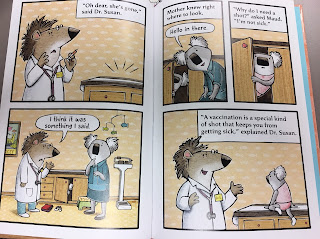
 The new Maud the Koala series by J. E. Morris makes broad
use of the sort of graphic novel style panels we’ve seen used so effectively in
other beginning readers, with colorful illustrations in a woodcut style. Where
the series really excels is in portraying Maud’s experiences in a way that
makes her anxieties relatable and accessible to the target audience.
The new Maud the Koala series by J. E. Morris makes broad
use of the sort of graphic novel style panels we’ve seen used so effectively in
other beginning readers, with colorful illustrations in a woodcut style. Where
the series really excels is in portraying Maud’s experiences in a way that
makes her anxieties relatable and accessible to the target audience.
In Much Too Much
Birthday, effective use is made of both text and illustration to depict how Maud’s “You can
never have too much birthday” attitude is changed as she is squeezed, squashed,
jostled, and jabbed. Maud’s pursuit of a little quiet seems entirely natural. There is excellence in the use of the illustrations to contrast the hectic party scene with the calm of the hiding place behind the bushes. Washing out the party scene to allow the reader to focus on the characters referenced in the text is supportive of young readers relying on picture clues to support their decoding. The
ending empowers Maud to find her own solutions, both for herself and her friend
Simon, which is very respectful of a child reader.
In Fish Are Not Afraid of Doctors, Maud is nervous about her
checkup and getting a shot. By pretending to be a fish, she gets through the
experience just fine and gets a sticker as a reward. There is plenty of
repetition of vocabulary like “vaccinations” and “pretended” throughout, and
the illustrations are vibrant and engaging. The use of panels keeps the story
moving for a reader. Vaccination is at one point phonetically misspelled as “vax-i-nay-shun”,
which may help a more confident reader with a potentially unfamiliar word.
An adult directed Note to
Caregivers at the end of each book in the series calls out the techniques
depicted in the story which may help children cope with an overwhelming
situation, yet for the most part the series avoids feeling like didacticism has
outweighed considerations of quality.
Librarians often hear from parents looking for an updated
picture book to prepare their child for experiences like visiting the doctor or
dentist. Maud the Koala fills this need, and I wouldn’t hesitate to include it
in my recommendations to parents. However, it’s this strength that makes me
question whether Maud the Koala is really intended for independent reading.
Despite its beginning reader trim size, the font and leading are not as large
or spacious as we would expect from text directed at beginning readers. Because
of the effective use of panels, there’s quite a bit of text on most two-page
spreads, and some lengthier sentences. Overall, intended audience would appear
to be a child and caregiver together, right down to the caregiver note at the
end of each books. Of the two, I think Much Too Much Birthday is more qualified as a Geisel Contender, but I think the true strengths of Maud the Koala may be best
appreciated during shared rather than independent reading. What do you think?



No comments:
Post a Comment
Note: Only a member of this blog may post a comment.